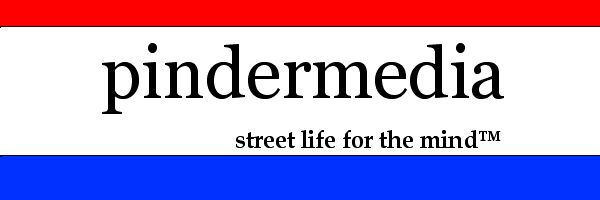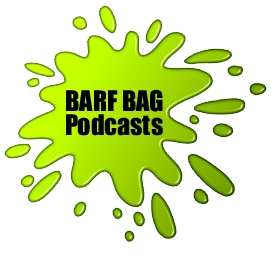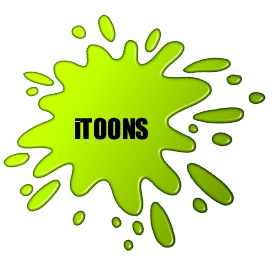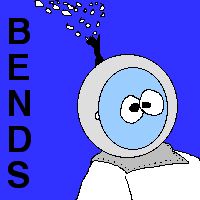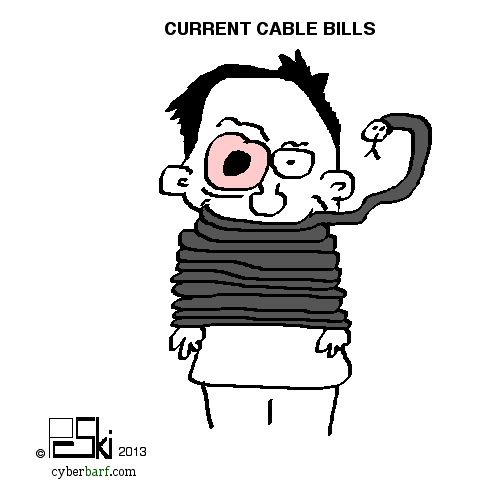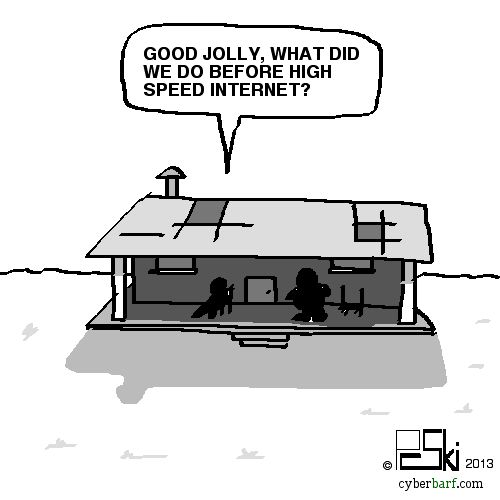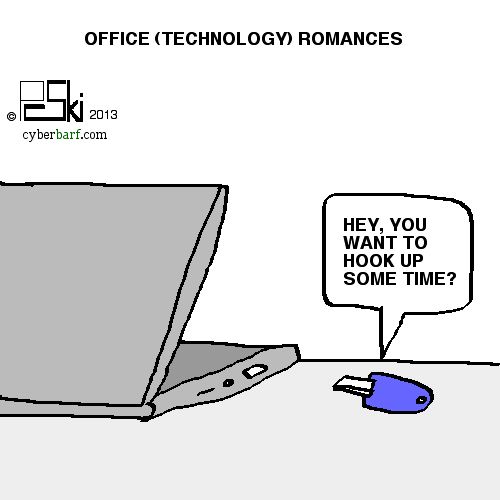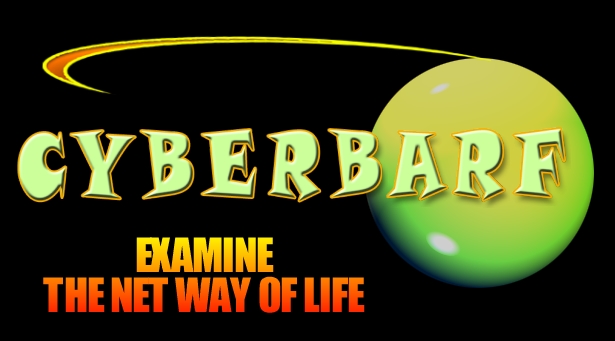|
AUGUST 2013 IN THIS ISSUE:
ZING GONE CONTENT IS KING BENDS & TRENDS DE-EDUCATING iTOONS CABBAGE PATCH IN JOURNALISM WHETHER REPORT NEW REAL NEWS KOMIX! SHOW HACK!
|
|
cyberbarf EXAMINE THE NET WAY OF LIFE
For every ending, there is a new beginning: NEW REAL NEWS KOMIX! SHOW HACK!
CYBERBARF T-SHIRTS, MUGS & MORE
THANK YOU FOR YOUR SUPPORT!
CYBERBARF
THANK YOUR FOR YOUR CONTINUED SUPPORT.
|
|
cyberbarf ZING GONE GAMES COMPANIES PLAY Someone had bought the farm. In its latest earnings statement filed last month with the Securities and Exchange Commission, Zynga, the creator of games like Farmville, reported the number of daily average users (DAU) dropped to 39 million in the second quarter of 2013—the lowest ever since the company began keeping track. Last quarter, the DAU fell to the then-lowest record, 52 million users. The fall to 39 million means that a dramatic 25 percent of its daily user base quit playing its games. It shows once again how fickle the general public can be to things that are HOT and NEW. The once top-dog has gone through a bit of a rough patch during the last year. In the summer of 2012, the company quickly lost a bunch of executives and managers. That October, the company announced that it had overpaid for OMGPOP (maker of Draw Something). More recently, Mark Pincus, the company’s founder, was ousted as CEO in early July 2013. Then Zynga suddenly shut down OMGPOP. The earnings report also crapped out on a potential new source of revenue. Zynga was going to bring “real-money gaming” (aka, gambling) to the United States. But the federal government is still against interstate online gambling so the matter continues to lose ground. If that strategy was the company’s last chance to regain profitability then the pioneering gaming franchise could be in trouble. It tried to seek a partnership with Wynne Casinos for an online gambling site, but Wynne said it was not interested in that speculative field. Which leaves Zynga as a game platform that seeks to lure causual gamers into their products then up-sell revenue. What hurts is that its deal with facebook expired late last year. That was the distribution engine for its games. Now, facebook is looking to become a game developer for its site. “Zynga believes its biggest opportunity is to focus on free to play social games,” the company wrote in its 8-K filing. “While the company continues to evaluate its real money gaming products in the United Kingdom test, Zynga is making the focused choice not to pursue a license for real money gaming in the United States. Zynga will continue to evaluate all of its priorities against the growing market opportunity in free, social gaming, including social casino offerings.” The freemium model is to give the basic game app away for free, but allow a player to purchase in real money upgrades, hints, cheats, new levels or accessories to enhance their game experience. Brian Blau, an analyst at Gartner Research, told Ars Technica that Zynga has to move forward in a new direction. “They are clearly in a transition, one that will last well into 2014 as they revamp their business and try to salvage what they can. Zynga does have talent, resources, and a real chance, but they first must refocus on their core capabilities, make the transition to mobile, and build out their platform before we start to see improvement in their bottom line. Game companies have resilience, they can regain game players but they first must build that platform and launch new games.” This statement can apply to any technology company, not just game manufacturers. Take for example the smart phone market. Many analysts believe that the smart phone area is reaching a saturation point where any consumer who wants a smart phone has already purchased one. Even with new features, most users will be keeping their phones for longer time periods. Profit margins to manufacturers will begin to get squeezed and dead money inventories rise which could cause a negative cascade effect throughout the entire tech sector. People should remember the history of telephone tech is not that old; Blackberry used to be the king of corporate IT and Nokia was the number one seller of portable telephones. Now, both companies are barely hanging on. Each company tries to re-invent itself, but once a company gets behind a technology curve, it is tough to make up ground. Game companies can be caught like a sailboat on a lake without a breeze. Remember when everyone was talking about Angry Birds? There was to be a movie, spin offs while riding the great wave of popularity. No really talks about that little addictive game anymore. And that is the problem with the hit or miss of mobile gaming: the short window for insane fandom is short. Pure gamers will pay $50 for the latest console game because the story, special effects and camera movements rival that of any summer blockbuster movie. For 40 plus hours of game play, the console beats a $20 movie of 90 minutes duration. The best mobile games are the simple but addictive variety spread by word of mouth like wildfire. And for every successful app story, there are 10,000 app failures. There are very little margin for error and few second chances for game developers once their cash cow no longer gives milk.
cyberbarf EXAMINE THE NET WAY OF LIFE
cyberbarf CONTENT IS KING COMMENTARY Television was once called The King. Three networks created shows that would bring live entertainment into America's living rooms. Those early network shows would help mold American culture for generations. At the time of the rise of television, it was said that TV would kill off the existing medium of the time: radio. As radio was primarily a local hub, television networks brought together national audiences. The power in numbers drove ratings. Ratings drove advertising rates. High advertising rates meant larger profits and more development of new shows. As with radio before it, TV has several questions to overcome. Would there be an audience for whatever we broadcast? Would they expect to buy receivers and get shows for free? Would the public accept advertising in exchange for a free product? As television answered those early questions, those same questions are now being asked about digital streaming services. But now, many believe that the new paradigms in digital media will kill off television. Television has evolved from three networks showing specific programs at specific times to cable on demand. In the origins of television programming, if you missed your show, you would have to watch it in a re-run 26 weeks later. Cable television scrambled the date and time set parameter of television. It destroyed the three network stronghold to create hundreds of niche channels. Technology such as the VHS/Betamax recording systems allowed consumers, for the first time, to time shift their viewing habits. The Courts sided with the consumers when the networks and show producers claimed copyright violations for these time shifting mechanisms. Program producers have gotten cable companies to copy protect broadcasts to stop consumers from time shifting programs. Cable companies have offset those restrictions by putting on-demand features into their set back machines (at a monthly fee). Now, some sat TV alternatives are using on-demand virtual DVR services to re-create the consumers right to time shift even cable blocked programming. Program producers are fighting these new time shifting services, but so far they have not succeeded because of highly technical reasons. Now young internet content producers are looking to merge podcasts, video casts, web programs to create a parallel television like consumer experience. They need to create a loyal web audience to go to a bigger distribution platform like television or cable to upsell their shows. Some call it transmigration, or bridging the gap between younger, hipper content consumers who see YouTube and other Internet channels a more appealing source for entertainment than standard cable television. The Internet i's basically free. The Internet is always on demand. And it is not even the quality of the programs (memes, drunk Russian gun footage, or painful fail videos) that continues to captivate the digital consumer. It is the freedom to find interesting to weird to bad things without investing any time, money or effort. Digital streaming is not killing off television, it is killing off dead hours in consumers daily lives. Digital content producers have hit upon one thing conventional television cannot provide: interaction with fans, some in real time. If show hosts can interact with viewers, many viewers become attached to the program. They are now invested in the program (as their own guilty pleasure). Once they are invested emotionally in a show or host, they will hope it will succeed. They will follow the show to other platforms. And that is the only way digital content creators can monetize their talent. It does not matter what the distribution means is in the future, all that will really matter is the content. Consumers want to consume original content. Like it or not, content is the new processed food for the entertained brain. The Internet is still such a wild west open range that no one can fully corral the public to view digital content as a standardized commodity. They are trying with monthly fee music sites or Internet radio stations. Netflix and Hulu are trying to add more popular shows and their own original programs in order to get to “main source” status that the networks once had in the entertainment industry. Many people believe that technology companies such as Apple, Amazon or Google will merge the Internet IP with television sets to create a hybrid, all-in-one entertainment hub. But those technology companies are not entertainment content providers. There are so little “free” content uploaders of videos, skits and web series that gain any large audience traction. That is why any hybrid IP-TV system will need to have pre-paid content libraries from existing big media companies to survive, just as cable needs to pay for content from all its channel producers like Disney, ESPN, or Fox. But those big media companies have their sluggish creative formats which seem old and tired to the next next mobile digital consuming culture. The web has allowed artists the freedom to create their own content, and not the sausage by committee that still permeates conventional television programs. Web artists have cheap technology, plenty of time, and a free distribution system to compete with any major studio. At some point in time, there will be a balance between the current cable programming model and the upstart free web series channels. Consumers who want more content on their smaller devices like tablets and phones will push content providers to address their preferences in order to survive. But content not the distribution channel will become king of the new media.
cyberbarf BENDS & TRENDS
It's back after nearly a decade, Bends & Trends, quick hits on what is good and bad in cyberculture. cyberbarf DE-EDUCATING COMMENTARY I have recently spoken to many school teachers. In the course of our conversations, it has become apparent that the American education system is failing despite the knowledge that teaching the basics is still the most important aspect of learning. Teachers are getting frustrated by the decline in their own education system. They are put in direct conflict on how they were taught in the past by the introduction of new technology and a laisse faire student culture. Many children do not learn at an early age the basic building blocks of sound educational principles. Kindergarten is not mandatory. Some parents put their young children into day care pre-schools which look and function at a first grade level. There are activities just beyond play: art projects, reading, science, early math, alphabet learning, social skills like show and tell, and in religious settings, scripture readings. Many children start their formal education being able to read, write, understand time periods in a classroom, listen to a teacher, and how to interact with other children. Kindergarten and first grade teachers may have 25 children in their classes who are various levels of knowledge and comprehension. School administrations still focus in on the bare minimum requirements in order to promote students through the system. The least common denominator thinking is fine for children with learning disabilities or lack of private schooling, but the smarter or more educated students may be left behind in their learning path because they are ahead of the norm. That leads to boredom, anxiety and lack of motivation to learn more on their own. Teachers are finding more and more parents spent little time with their children's education. Rarely are parents supervising the children's home work. Parents, due to dual work schedules and activity driving siblings, have no time to sit down and help their children do their studies. Some teachers believe that if the parent does not take interest in a student's work, the student takes that signal that his educational work is not important or a priority. And in an odd way, that child is right in his assessment, especially in districts where it is mandatory to promote all elementary students to the next grade level (to keep classes together and not stigmatize a child). Technology is playing a role in the problems with modern education. The answer is now more important than the process to get to the answer. For example, students no longer are required to memorize math tables. The reason is that everyone has access to a calculator, no one needs to memorize 8 x 8. Likewise, students are being shown where to look for information (mostly on the Internet) rather than going to the library and reading textbooks to find answers. A search engine will spit out a two sentence summary of an event. But a textbook on the same subject may contain an entire chapter of information, context and other leads to other source material. Instead of a two page, type written bibliographed term paper on a historical event, students now routinely turn in one paragraph cut-and-paste Google or Yahoo search result pages. And students are getting away with this because schools are more concerned about how to train children how to find the answers than learning and retaining the answers in their own memories. If a student does not learn to retain information, then that student will not know how to make comparisons or apply this knowledge to other events or questions. Schools no longer teach cursive handwriting. It is mind boggling that a generation of American students will not know what cursive handwriting is, or how to read it. To them, it will be as foreign as the Egyptian hieroglyphs. The excuse is a poor one by administrators. They claim that in the computer age, students will not need fancy handwriting. Everything will be done on a computer anyway. But that misses the practical applications of cursive handwriting. As a adult, cursive handwriting identifies a person by his or her own signature - - - a key element for most business transactions such as banking, borrowing, signing contracts, etc. Signatures are important means to weed out fraud and forgery. But those practical aspects of basic writing is lost in the school system. Block letters is all that children will be learning in school. It really deadens an aspect of early childhood learning: that something like a word can have multiple representations: block letters, ALL CAPS or cursive. The latter could spark an area in the brain that sees the curved letters as art - - - and spark further creativity. But what is missing from any school's argument is that most of our historical documents are handwritten documents. By denying the children's ability to be able to read old documents, handwritten letters or notes, it is a resolution that ignorance is okay in a computerized society. Even with older students, political correctness limits the type of experiments in schools. Frog or piglet science dissections are banned because it is cruelty to animals. But how are students supposed to learn about biology? Scalpels and kill jars are no longer part of the science curriculum. But the real bane to teachers is the rapidly disintegrating spelling and grammar of student writing. Text messaging and tweets have made this generation sloppy in spelling and unable to fashion complete sentences. The children are being conditioned to respond to inquiries in 140 characters or less. They do not have direct conversations with their friends anymore. Most of it is electronic pings and abbreviations. A growing number of students have trouble stringing together coherent sentences together to make meaningful paragraphs. Many students think that word processing spell checkers will handle their inability to spell, but they have no idea whether the spell checker is actually put in the right word in the sentence. Many students also believe that if grammar is not important in their personal communications, that is the same in the “real” world after graduation. They are terribly wrong. Teachers meet constantly with parents on these issues. They report receiving nods, blank stares and shrugs from parents. Early childhood development is the key to life long learning. If a child is excited about reading, having the ability to use their own hands to explore nature or science, and the ability to write and express themselves, they will have the opportunity to succeed in life. The building blocks of all learning is the basics that served prior generations well: reading, writing and arithmetic. But this foundation has been cracked by the myths of the computer age: tweets, voice recognition, videos and information apps are the future so we do not need to learn the educational tools of the past.
|
|
THE PINDERMEDIA STORE IS FULL OF FUN T-SHIRTS CLOTHES, HATS AND OTHER ITEMS. CHECK OUT THE STORE FOR ITEMS
SUPPORT cyberbarf VISIT THE CYBERBARF STORE! Prices may vary depending on sales, allotments, inventory. |
|
cyberbarf.com EXAMINE THE NET WAY OF LIFE iToons
cyberbarf CABBAGE PATCH IN JOURNALISM ESSAY More and more local PATCH editors are leaking unkind memos and remarks about their current situation. AOL decided to create hyperlocal news sites as a means of driving traffic. The concept lured laid off reporters and citizen journalists who wanted to move up from blogging to a bigger venue. Many major news organizations have relied on citizen journalists, eyewitnesses or iReporters and smart camera shutterbugs to feed them with breaking news stories, information and images. There remains an innate curiosity in humans to know their surroundings, including the keys to local news reporting: police and fire reports, local high school sports, weather, city news and obituaries. Many small town newspapers remain profitable by following this simple formula. The PATCH system was set up by technologists and business majors who probably had little actual news gathering, editing or printing experience. They relied upon the platform to carry the day; stream line the news posting function (by in some cases following the HuffPo model of cut, paste and link to other site content.) In 2011, the goal was to create a single web page for every local town. A reporter-editor would write, edit and publish town specific news for that Patch site. The idea was that local news would drive local readership and local advertising. This reporter would then create a team of freelancers working the area to cover news, government, civic events and sports. As a startup, AOL's Patch was trying to build a platform that could replace a disaggregated network of local news sources. It thought it could capture a large market, like the approximately 54 million school-aged online children in the U.S. who do not consume conventional media. Even if those children do not care about local events, they have parents who care about the goings on of the world, but also need to know about the community issues that will affect their families. In just one year, Patch’s readership grew to six million monthly unique visitors. But that is the total of all Patch sites. Each individual site was not sustainable even it would disruptive existing local media businesses. The concept of stringing together a 1,000 costly miniature websites instead of one large, national web presence has not led to any profitability because Patch has failed to create value for its customers. It's small site traffic flows do not attract local advertisers who can get as much online presence with their own web site. Patch's micro-newspaper on a page model in theory sounded promising but in execution did not fly well. Executives demanded that Patch leaders produce more and more local stories and pictures to drive traffic. There was little room to add staff. There was little time to go into the field to do actual news gathering. The quality (which was suspect from those new to journalism) and quantity of stories began marginalized in the face of more executive demands. Burn out was the leading cause of staff exits. Patch sites without a paid staffer had nothing to keep it moving forward. By 2012, Patch has implemented a new “One Team One Goal” strategy, with a budget that effectively eliminated 50 to 100 percent of freelance dollars, depending on the Patch region and how the supervising editor and regional ad director choose to allocate dollars. The editorial emphasis is now on “easy, quick-hitting, cookie-cutter copy,” including mandatory “Best Of” features (i.e., best coffeeshop, best burgers, best pizzas etc.) that compel businesses and readers to visit and participate in the Patch directories. Patch wanted to create a directory of local businesses, organizations, churches to pull in viewers. Management decided to create Pizza Playoffs — a site featured tournament-style bracket that pits all the pizza parlors in town into showdowns to attract the most comments and star-ratings. Features like this could go on for weeks at a time, and when one ends, a new one would begin. In addition, the Patch network decided to shift from covering local news site to a local news aggregator. Since other companies made fortunes by linking to other content pieces (without paying for it), it seemed like a more profitable business model. Journalism took a back seat to web page design and links to trending stories. A local Patch without local news was not different than a dozen other regional news portals. It offered nothing new. So to keep the original Patch idea, executives through the directive that editors needed to continue to do their daily assignments plus add aggregation to each page. By 2013, the Patch system began to shift focus to story swapping within their network. The change ion philosophy is to now build sites to be content-sharing and community-organizing tools for their areas. Editors won't go away entirely, but there will be fewer of them, writing for more sites. The contraction of human resources is not going unnoticed. Many existing Patch sites in a local area mysteriously went from having local editors to links to “staff” and most of the sites are now distributing much of the same news across the different Patches. A story in Patch 1 would simultaneously run in a dozen other Patch sites, sometimes with the byline of a different reporter. This ran afoul with journalists. It was a white lie to state to the reader that a site reporter did the leg work on a piece when that story was from other sister site. It was also a disservice to the original writer. But the executives running the Patch system were not born and bred in the newspaper business. They still believe digital reporting is different than stale old newspaper reporting. Citizen journalism has looser rules, if any at all. The promise of the Patch system is still based on the hope that local printed papers will publish less and less local news so that readership will seek out other local news alternatives. Patch is hoping that three local stories, a weekly crime blotter, republish press releases and semi- paid feature advertising stories on local merchants will be enough for viewers to bookmark the page. But the advertising revenue is still not there. Banner and click ad views do not drive rate cards in hyperlocal sites. The Patch system will continue to struggle professionally and financially. It's business model is constantly changing because nothing is really working well.
|
|
cyberbarf THE WHETHER REPORT |
cyberbarf STATUS |
| Question: Whether federal immigration reform will improve technology manufacturing in the US? |
* Educated Guess * Possible * Probable * Beyond a Reasonable Doubt * Doubtful * Vapor Dream |
| Question: Whether the federal government's massive personal data collection efforts will fall prey to abusive or corrupt activities? |
* Educated Guess * Possible * Probable * Beyond a Reasonable Doubt * Doubtful * Vapor Dream |
| Question: Whether a federal mandate for all web retailers to remit individual state sales taxes will severely disrupt interstate commerce and raise the cost of goods to the general public? |
* Educated Guess * Possible * Probable * Beyond a Reasonable Doubt * Doubtful * Vapor Dream |
|
cyberbarf EXAMINE THE NET WAY OF LIFE |
Never tell people how to do things. Tell them what to do and they will surprise you with their ingenuity. George S. Patton
|
|
BACK IN BLACK WITH THIS CLASSIC CYBERBARF T-SHIRT!
FEATURING: THE REAL NEWS IMPACT EDITORIAL CARTOONS WRIGLEYVILLE WAR POLITICS ENDORPHIN RUSH THE DARK ABYSS RANDOM ELECTRONS SPECIALS
FEATURING: THE REAL NEWS ARCHIVES CARTOONS MADAME'S TEA HOUSE THE BAR EXPLORE THE CITY SCAPE UNDER CONSTRUCTION SURPRISES ESTORE SPECIALS |
cyberbarf
THE STEAM PUNK SPECIAL EDITION featured new Music from Chicago Ski & the (audio) Real News: (mp3/4:14 length)
EXAMINING THE NET WAY OF LIFE cyberbarf™ distributed by pindermedia.com, inc.
|
cyberbarf
Distribution ©2001-2013 pindermedia.com, inc.
All Ski graphics, designs, cartoons and images copyrighted.
All Rights Reserved Worldwide.
